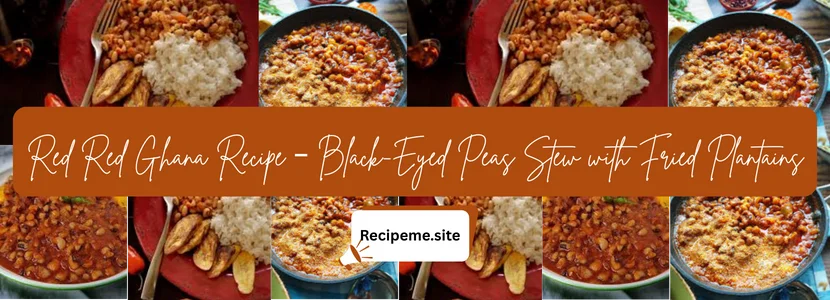
Introduction
What if comfort could be served on a plate? In Ghana, it often comes in the form of Red Red (Black-Eyed Peas Stew with Fried Plantains).
Rich, hearty, and full of character, Red Red is a dish that brings together the earthiness of black-eyed peas with the sweetness of golden, fried plantains. The combination is not only satisfying but also deeply symbolic of Ghanaian cuisine—simple ingredients transformed into something unforgettable.
I still remember the first time I tried Red Red at a small chop bar in Accra. The stew was spicy, smoky, and deeply flavorful, and the fried plantains added just the right touch of sweetness. It was love at first bite.
But Red Red is more than a meal—it’s a cultural staple. So, let’s explore how this beloved dish came to be and why it remains one of Ghana’s most iconic foods.
History of Red Red
The name Red Red comes from the reddish hue of the stew—derived from palm oil (called dzomi in the Ga language) and tomatoes. When served alongside ripe fried plantains, the plate becomes “red on red.”
Historically, black-eyed peas (cowpeas) have been a vital source of protein in West African diets. Combined with palm oil, smoked fish, and spices, they created a nutrient-rich dish that sustained generations. Over time, fried plantains became the perfect companion, balancing the savory stew with sweetness.
Did you know? Red Red was originally a Ga-Adangbe dish from southern Ghana but has since spread across the country, becoming a national favorite.
Essential Ingredients
To make authentic Red Red, you’ll need:
-
Black-eyed peas (cowpeas) – the base of the stew.
-
Palm oil – for its vibrant color and unique flavor.
-
Onions – for depth and sweetness.
-
Tomatoes (fresh and/or paste) – to build the sauce.
-
Pepper (scotch bonnet or chili) – for heat.
-
Garlic and ginger – for aromatics.
-
Smoked fish or shrimp powder – adds a smoky, umami richness.
-
Seasoning cubes and salt – for taste.
-
Ripe plantains – sliced and fried golden brown.
Optional additions: bell peppers, garden eggs (African eggplant), or spinach for extra variety.
Variations of Red Red
Every Ghanaian household makes Red Red a little differently:
-
Vegetarian Red Red – cooked without fish, often with mushrooms or spinach.
-
Seafood Red Red – with dried shrimp or smoked fish.
-
Spicy Red Red – with extra chili for heat lovers.
-
Lite Red Red – made with vegetable oil instead of palm oil (less traditional but lighter).
Preparation (Step-by-Step Guide)
Step 1: Cook the Black-Eyed Peas
-
Rinse and soak the peas for a few hours.
-
Boil until tender but not mushy. Drain and set aside.
Step 2: Prepare the Stew Base
-
Heat palm oil in a saucepan.
-
Add chopped onions and sauté until soft.
-
Stir in garlic, ginger, and pepper.
-
Add tomatoes (fresh blend + paste) and cook down into a rich sauce.
Step 3: Flavor and Combine
-
Add smoked fish or shrimp powder for depth.
-
Season with salt and stock cubes.
-
Gently stir in the cooked black-eyed peas and simmer.
Step 4: Fry the Plantains
-
Slice ripe plantains diagonally.
-
Fry in hot oil until golden brown.
-
Drain on paper towels to remove excess oil.
Step 5: Serve Together
Dish out the black-eyed peas stew and serve with fried plantains on the side—or right on top.
Cultural Significance
Red Red isn’t just food—it’s identity. In many Ghanaian households, it’s served as both a weekday meal and a special weekend treat. Its affordability made it popular among students and workers, while its comforting flavors ensured it became a favorite at family tables.
It’s also a social dish. In local chop bars, you’ll often see people eating Red Red together, accompanied by lively conversation.
Serving Suggestions
-
With fried ripe plantains (the classic pairing).
-
Alongside gari (grated cassava) for extra crunch.
-
With white rice for a more filling version.
-
Topped with avocado slices for a creamy touch.
Types of Red Red
-
Traditional Red Red – palm oil, smoked fish, and plantains.
-
Street Food Red Red – simpler, often without smoked fish.
-
Restaurant Red Red – elevated with avocado, salad, or grilled chicken on the side.
Tips for the Perfect Red Red
-
Use very ripe plantains—the sweeter, the better.
-
Don’t skip palm oil if you want authentic flavor.
-
For extra richness, cook the stew slowly to allow the flavors to deepen.
-
Add a little shrimp powder or smoked paprika if smoked fish isn’t available.
Did you know? Some Ghanaians like to eat Red Red with a sprinkle of gari on top—it adds crunch and makes the meal even more filling.
Other Valuable Information
Nutritionally, Red Red is a powerhouse. Black-eyed peas are rich in protein and fiber, plantains provide potassium and vitamins, and palm oil contains antioxidants like vitamin E. Together, they create a balanced, nutrient-dense meal.
It’s also gluten-free and adaptable for vegetarians and vegans, depending on ingredient choices.
Personal Experience / Journey of Discovery
I once joined a Ghanaian friend’s family dinner where Red Red was the star of the evening. What amazed me wasn’t just the food but the atmosphere it created—laughter, storytelling, and a sense of togetherness.
Eating Red Red made me realize that this dish isn’t just about flavors—it’s about community and tradition. Every spoonful carries with it the warmth of home and heritage.
A Reflective Closing
Red Red (Black-Eyed Peas Stew with Fried Plantains) is more than a meal. It’s Ghana’s way of turning simple, humble ingredients into something deeply satisfying and culturally meaningful.
If you’ve never tried it, this dish is an invitation to experience Ghanaian hospitality on a plate. Once you taste it, you’ll understand why Red Red is a national treasure.
Frequently Asked Questions
1. Why is it called Red Red?
Because the palm oil stew is red, and when paired with fried ripe plantains (which also turn reddish-golden when fried), the meal looks “red on red.”
2. Can I make Red Red without palm oil?
Yes, though it won’t taste as authentic. You can substitute with vegetable oil, but the color and depth of flavor will differ.
3. Is Red Red a vegetarian dish?
It can be! Just skip the smoked fish and shrimp powder, and use vegetables like mushrooms or spinach instead.
4. What can I serve with Red Red besides plantains?
You can serve it with rice, gari, or boiled yam as alternatives.
5. Is Red Red healthy?
Yes. It’s high in protein, fiber, potassium, and antioxidants, making it a nutrient-rich meal.
6. Can Red Red be made ahead of time?
Absolutely. The stew keeps well in the fridge for up to 3 days and often tastes even better the next day.
